Morphology mediation of MoS2nanosheets with organic cations for fast sodium ion storage
2021-05-14JinjinLiCongcongLiuJingjiangWeiYuantaoYanXiaoliZhaoXiaoweiYang
Jinjin Li, Congcong Liu,Jingjiang Wei,Yuantao Yan,Xiaoli Zhao*,Xiaowei Yang
School of Materials Science and Engineering, Tongji University, Shanghai 201804, China
ABSTRACT Ion diffusion kinetics,depending on the size,tortuosity,connectivity of the channels,greatly affects the rate performance of the electrodes.Two-dimensional materials (2DMs) has emerged as promising electrode materials in the past decades.However,the applications of 2DMs electrodes are limited by the strong restacking problem, which leads to a poor rate capability.In this work, we for the first time mediated the morphology of molybdenum disulfide(MoS2)nanosheets via a facile coagulation method;abundant sheet crumples were induced, which greatly enhance their surface accessibility and thus benefit the ion diffusion kinetics.Consequently,the crumpled-MoS2electrodes follow a capacitive Na-ion charge-storage mechanism to a large extent.Importantly, we demonstrate the special role of organic cations in the inter-sheet assembly configuration, in sharp contrast with that of alkali/alkaline-earth ones.We propose that organic cations cause edge/face contact of the sheets, instead of the face/face contact, thus affording a house-of-cards structure.
Keywords:Ion diffusion kinetics Crumpled MoS2nanosheets Anti-restacking Organic cations Na-ion storage
The development and demand of portable electronic and electric vehicles puts forward higher requirements for electrochemical energy storage[1–3].Ion diffusion kinetics greatly affects the rate performance, which is the key metric of electrochemical energy storage [4–7].Ion diffusion kinetics depends on the size,tortuosity, connectivity of the ion channels in the electrodes [8–12].Various strategies have been explored to mediate the porosity of electrode materials, such as reducing the materials to the nanometer scale[13,14],templating synthesis[15–17]and sol–gel chemistry techniques [18,19].
Recently,Two-dimensional materials(2DMs)have shown great promise for electrochemical energy storage[20–23].As one of the representatives, MoS2has attracted increasing research interest because its interlayer can provide sites for ion storage and allow reversible de/intercalation of ions[24–27].However,the practical applications of MoS2nanosheets anodes are limited by the restacking of 2D nanosheets due to the strong van der Waals attraction, which causes a poor rate capability [28–30].Various structural design strategies have been developed to address this issue [31–35].For example, Gogotsi and co-workers fabricated a free-standing MoS2@carbon paper electrode featured with a hierarchical structure, in which MoS2nanosheets are vertically aligned on carbon scaffolds,effectively avoiding their aggregation to enable sufficient electrode/electrolyte interaction and excellent rate capability for sodium-ion batteries [36].Lou and co-workers synthesized hierarchical MoS2microboxes constructed by ultrathin nanosheets with highly exposed active edge sites and large specific surface area,which manifest excellent electrochemical properties as anode materials for lithium-ion batteries[37].Nevertheless,due to the rigidity, the absence of functional groups and insufficient bonding sites of MoS2nanosheets,it is still a challenge to achieve the direct assembly of individual MoS2sheets without compromise in its surface accessibility [38,39].
The nanosheet morphologies are critical in designing multiscale structures and performances of macroscopic materials [40].Typically, Huang’s group reported that compared with flat or wrinkled sheets, the crumpled graphene“paper balls”, which can resist compression from any direction without unfolding, deliver much higher specific capacitance and better rate performance[28].The hierarchically wrinkled morphology by poor solvents enabled the fabrication of amorphous self-standing graphene papers with a rubber-like mechanical behavior with viscoelasticity [41].The morphology mediation of MoS2nanosheets should be an effective approach to realize MoS2electrodes with high rate performance.
Herein, we investigated the morphology mediation of MoS2nanosheets via a facile coagulation method to solve the strong restacking problem of 2DMs.Importantly, the organic cations of ionic liquids, (1-butyl-3-methylimidazolium tetrafluoroborate([BMIM]BF4),caused edge/face contact of the sheets and afforded a house-of-cards structure,instead of the dense sediments with the face/face contact caused by the alkali/alkaline-earth cations(Mg2+,K+).This restacked-resistant structure with abundant mesopores possesses the interconnected ion transport channel, thereby ensuring the accessibility of electrode materials and shortening the length of Na-ion diffusion paths.Benefitting from these advantages, the MoS2-[BMIM]+electrode exhibits superior rate performance for Na-ion storage.
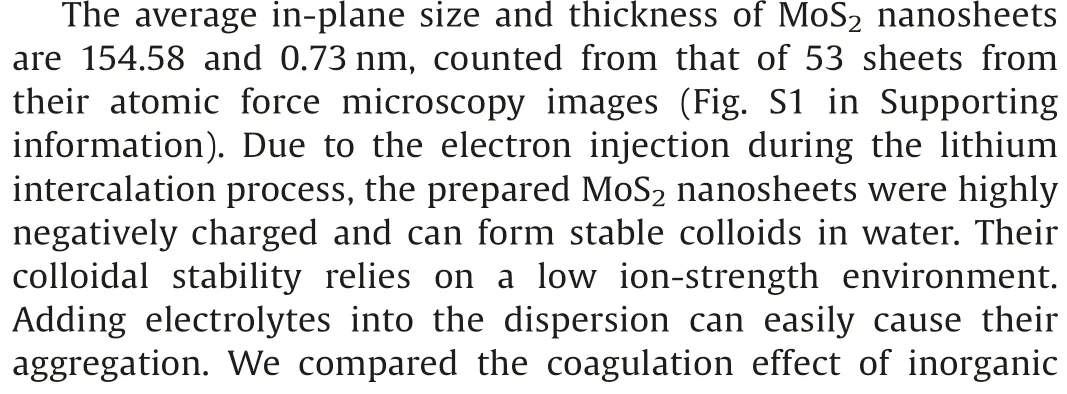
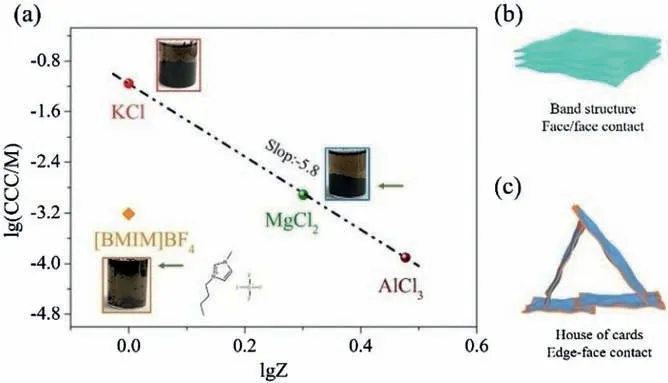
Fig.1.(a)The critical coagulation concentration(CCC)plotted with the valence of cations (Z).The insets are the optical photos of the coagulated MoS2colloids.The MoS2aggregates with[BMIM]BF4appeared as floated clusters of flocs,while that by KCl and MgCl2appeared as sediments.The specific adsorption (due to chemical interaction) of [BMIM]+on MoS2nanosheets, or probably MoS2nanosheet edge,makes its CCC largely deviate from Schulze-Hardy law (CCC.(b,c) The schematic illustration of (b) band structure and (c) house-of-cards structure.
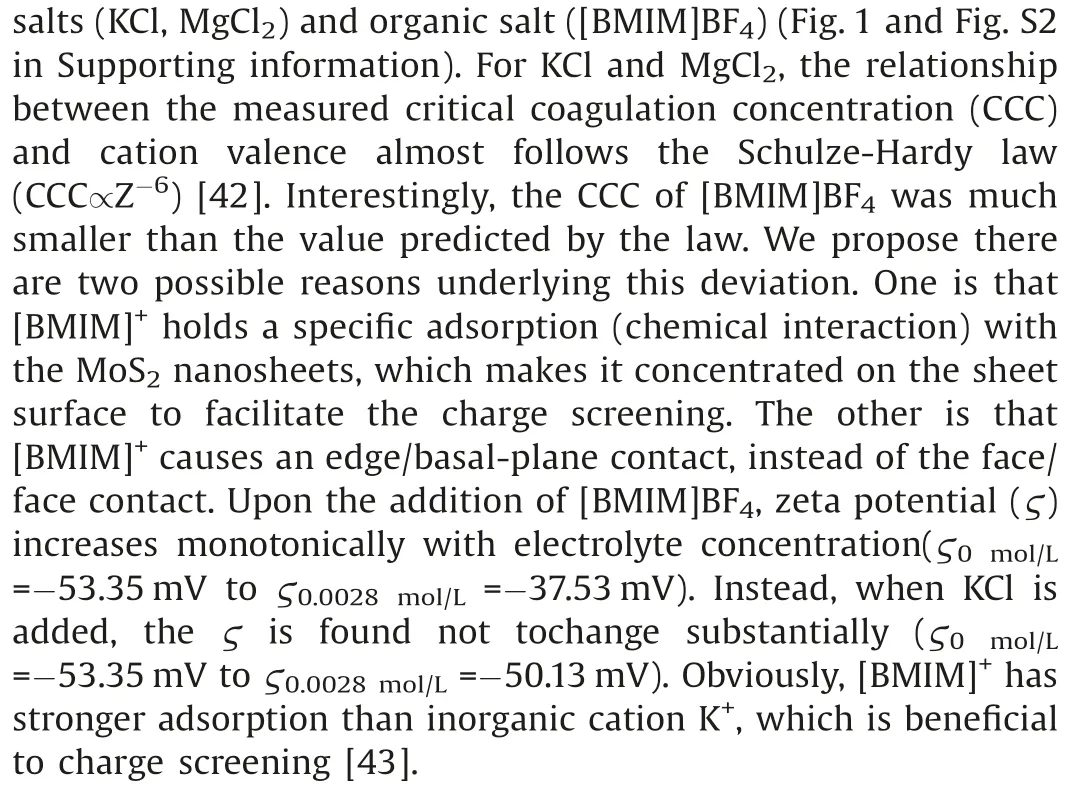
Schulze-Hardy law is the derivate of Derjaguin-Landau-Verwey-Overbeek (DLVO) theory, in which the 2D sheets are treated as homogeneously charged tablets.The ion strength should increase to CCC to sufficiently weaken the repulsive electrostatic force, which cause the face/face stacking (Fig.1b).In the case of MoS2nanosheets, the edge and basal plane (i.e., face) share different properties.The edge comprises poorly coordinated Mo atoms,while the basal plane comprises well-coordinated ones.The edge shows a higher surface energy and polarity than that of the basal plane[44].When associating with cations,the edge is prone to undergoing a charge reversal ahead of the basal [45].Then the edge and basal plane hold opposite charge sign, coagulation happens under an edge-face contact with a house-of-cards structure (Fig.1c), without the need to overcome the inter-sheet repulsion.With this configuration, the CCC would be below the value predicted by Schulze-Hardy law.Note that the MoS2aggregates with [BMIM]BF4appeared as floated clusters of flocs,while those with KCl and MgCl2appeared as sediments.This phenomenon supports the assumption that [BMIM]+induces a coagulation with house-of-cards structure.To verify this assumption, we investigated the microstructure of the aggregates with different electrolytes (Fig.2).

Fig.2.Microstructures of (a-c) bare-MoS2, (d-f) MoS2-[BMIM]+and (g-i) MoS2-Mg2+.(a, d, g) Schematic illustration.(b, e, h) TEM images.(c, f, i) SEM images.
The typical TEM image(Fig.2b)showed that the directly dried MoS2(denoted as bare-MoS2) exhibits a smooth surface and large-area restacking.For MoS2-Mg2+(Fig.2h), seen from the edges of the aggregates, they consist of thinner MoS2laminate than that of bare-MoS2.In sharp contrast, the aggregates from MoS2-[BMIM]+appeared much thinner thoroughly; vivid folds can be found throughout the aggregates (Fig.2e).SEM image of bare-MoS2also showed their thick laminates without noticeable wrinkles(Fig.2c and Fig.S3 in Supporting information),while for MoS2-Mg2+, micrometers-long wrinkles can be found.In sharp contrast, the aggregates of MoS2-[BMIM]+showed a porous structure with folded thin MoS2laminates as the pore walls.We can infer that the porous structure is originated from the partially compressed house-of-cards structure; the van der Waals force forces the strut sheets to restack, while the high bending modulus of the MoS2sheets/laminates would resist the restacking.The folded morphology of the nanosheets/laminates indicates restack still happens locally, which, however, could resist further restacking with other laminates [28].MoS2-K+showed the similar morphology as MoS2-Mg2+(Fig.S4 in Supporting information).
Element mapping images of MoS2-[BMIM]+and MoS2-Mg2+samples are shown in Fig.S5 (Supporting information), in which the uniform distribution of N and Mg in MoS2nanosheets can be evidenced.Fig.S6 (Supporting information) shows the XRD patterns of bare-MoS2, MoS2-[BMIM]+, MoS2-Mg2+and MoS2-K+.The diffraction peak of bare-MoS2located at 14.5,corresponding to an interlayer distance of 6.15 Å and matched with the (002)reflection.After associated with [BMIM]+, Mg2+and K+, the new(002) diffraction peak and (004) diffraction peak appeared, and the interlayer spacing expanded to 10.0 Å, 11.8 Å and 9.3 Å,respectively.
As shown in Fig.S7a (Supporting information), the MoS2-[BMIM]+shows a type IV isotherm curve with a hysteresis loop,indicating the existence of a mesoporous structure [32].The Brunauer-Emmett-Teller (BET) surface area of the MoS2-[BMIM]+was 33.11 m2/g, which is four times that of the bare-MoS2(7.98 m2/g).The pore size distributions were derived from the Barrett-Joyner-Halenda(BJH)method(Fig.S7b in Supporting information).The pore size of bare-MoS2was concentrated at 2 nm,while that of MoS2-[BMIM]+was at 3 nm accompanied by a dispersive peak centered at 20 nm.In addition,the surface areas of MoS2-Mg2+and MoS2-K+were 2.04 and 2.35 m2/g, respectively (Figs.S7c and d in Supporting information).To further demonstrate the superior surface accessibility of MoS2-[BMIM]+, we measured the electric double layer capacitance (Cdl) at the potential range of 2.80 -2.90 V vs.Na+/Na(Fig.S8 in Supporting information),which is known to be proportional to the effective electrochemical surface area[46].The Cdlof bare-MoS2,MoS2-[BMIM]+and MoS2-Mg2+were 1.0, 2.9 and 0.51 F/g, respectively.Both the N2adsorption/desorption measurement and electrochemical active surface area conform the advantage of MoS2nanosheets with a crumpled morphology.For electrode materials, such porosity can not only reduce the ions diffusion length,but also provide enough buffer space to mitigate the volume change during the charging/discharging [32].
We investigated the phase composition of bare-MoS2and MoS2-[BMIM]+by XPS (Fig.S9 in Supporting information).For bare-MoS2,the high-resolution Mo 3d and S 2p spectra verified the presence of 2H MoS2and 1T MoS2, the peaks at 228.98, 232.08,161.78 and 163.18 eV correspond to Mo 3d5/2,Mo 3d3/2,S 2p3/2and S 2p1/2components of 2H MoS2, and the peaks at 228.38, 231.48,161.28 and 162.58 eV correspond to Mo 3d5/2,Mo 3d3/2,S 2p3/2and S 2p1/2components of T MoS2.Similarly, for MoS2-[BMIM]+, all peaks for 2H MoS2and T MoS2were observed, indicating that[BMIM]+does not alter the phase composition of MoS2nanosheets.
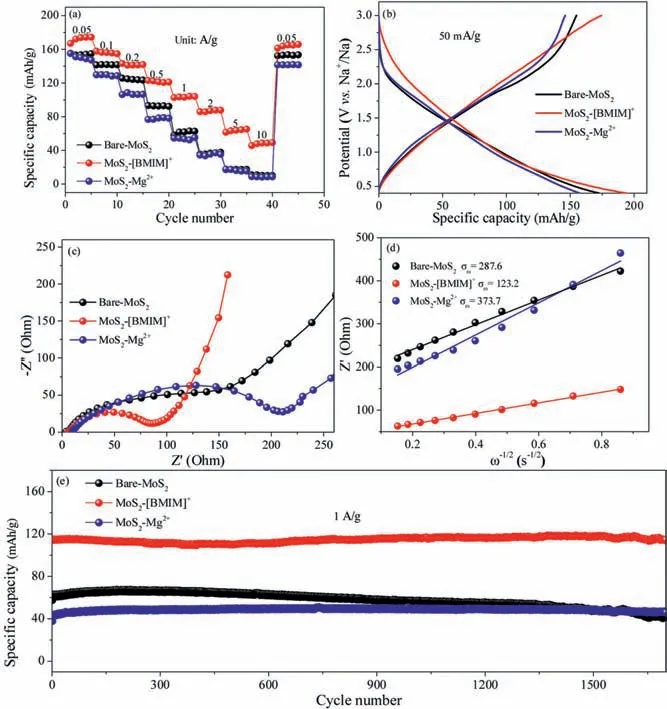
Fig.3.Electrochemical performance.(a) Rate performances.(b) Galvanostatic charge-discharge at 50 mA/g.(c) Nyquist plots.(d)The real part of the impedance plotted against at low frequency region.(e) Cycling performance at 1 A/g.
Fig.3 presented the sodium-ion storage performance under a cut-off voltage (0.4-3 V), because conversion reaction of MoS2starts at 0.4 V vs.Na+/Na and leads to poor structure stability.The capacity differences between MoS2-[BMIM]+and bare-MoS2,MoS2-Mg2+electrodes became more pronounced along with the increase of current densities from 0.05 A/g to 10 A/g(Fig.3a).Even at a high current density of 10 A/g,the reversible capacity reached mAh/g,while the bare-MoS2and MoS2-Mg2+electrodes showed almost no capacity.In detail,Fig.3b displayed the voltage profiles during the fifth charge–discharge cycle at 50 mA/g.The dischargespecific capacities of the bare-MoS2, MoS2-[BMIM]+and MoS2-Mg2+anodes were 172, 194 and mAh/g, respectively.In addition, the galvanostatic charging/discharging profiles of MoS2-[BMIM]+at different densities are shown in Fig.S10(Supporting information) and the electrochemical performance of MoS2-K+is shown in Fig.S11 (Supporting information).
To further examine the ion diffusion kinetics,the electrochemical impedance spectroscopy(EIS)was performed at the potential of 3.0 V(vs.Na+/Na)(Fig.3c).The curve of MoS2-[BMIM]+delivered a much smaller diameter of the depressed semicircle in high and middle frequency regions than that of bare-MoS2and MoS2-Mg2+,implying its superior charge transfer efficiency.The plots of Z' vs.are shown in Fig.3d.According to the formula,

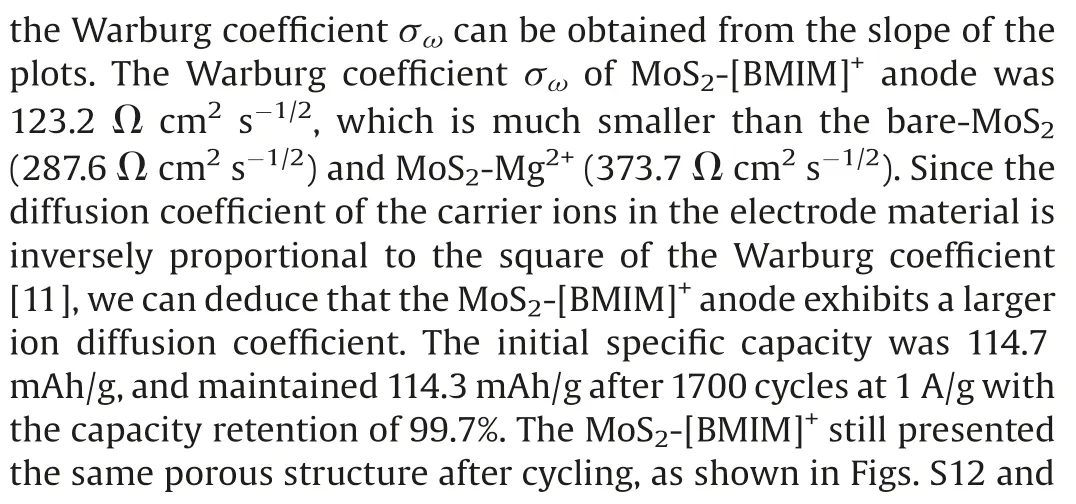

To determine the charge storage mechanism of MoS2-[BMIM]+anode,we perform a detailed quantitative analysis[47] of its rate performance(Fig.4).The CV curves at various scan rate showed a similar shape; the redox peak difference did not increase significantly along with the increase of scan rates (v, mV/s),indicating a small electrochemical polarization (Fig.4a).The current(i,mA)at different potential is plotted with v(Fig.4b).The i can be expressed as follows,

where k1and k2are the coefficient of capacitance-controlled and diffusion-controlledprocesses,respectively.AsshowninFig.4b,lgi was linearlyfitted with lgv,and theslope,denoted as b,at the three redox peaks were 0.92,0.87 and 0.9.One can expect that when the b approaches 1,the charge storage is mainly non- diffusion-limited capacitive process, and when the b is close to 0.5, the diffusionlimited process dominates.We can infer that the charge storage of MoS2-[BMIM]+is a hybrid process of capacitance control and diffusion control, and the capacitive Na+storage is the dominant.The quantitative capacitive contribution of MoS2-[BMIM]+at different scan rate is shown in Fig.4c, MoS2-[BMIM]+electrode showed a much higher capacitive contribution (72%,Fig.4d)than the bare-MoS2electrode (40%,Fig.S14 in Supporting information)at the low scan rate of 1 mV/s.These results clearly demonstrate that the highly open and interconnected pores in MoS2-[BMIM]+electrodes make the surface more accessible and shorten the diffusion path of ions [47,48].
We also examined the validity of MoS2-[BMIM]+in the full cells.We assembled the MoS2-[BMIM]+as anodes and commercial activated carbon (AC) as cathodes to form a sodium-ion hybrid capacitor.The electrochemical performances were tested within the voltage window of 1.0–3.7 V to avoid the electrolyte decomposition and the conversion reaction of MoS2.The mass ratio of MoS2-[BMIM]+anodes and AC cathodes is optimized to 1:4,to achieve the charge balance of the two electrodes.CVs between 0.5-10 mV/s are shown in Fig.S15a (Supporting information).
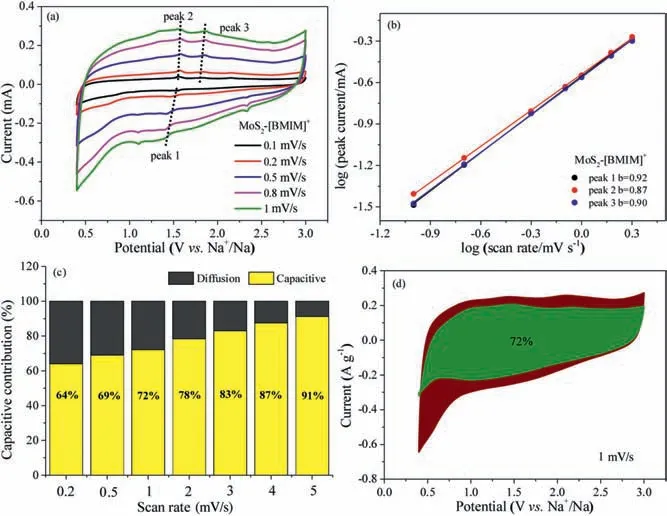
Fig.4.Electrochemical reaction kinetics of MoS2-[BMIM]+electrodes.(a)CV curves at different scan rates.(b) The current density at the peak potential in (a) plotted against scan rates.(c)Capacitive contribution at different scan rates.(d)CV profile at 1 mV/s.The capacitance and diffusion-controlled contribution are filled green and red.
The near-rectangular CV curves and the almost symmetrical linear curves of the galvanostatic charge/discharge profiles(Fig.S15c in Supporting information) demonstrate its capacitance-control charge storage mechanism and fast ion diffusion capability.The hybrid capacitor delivers a good rate performance with a discharge capacity of 84.8 mAh/g at 0.2 A/g and 36.1 mAh/g at 5 A/g.Furthermore, this hybrid capacitor preserves a capacity retention of 83.9%at a high current density of 1 A/g after 300 cycles(Figs.S15b and d in Supporting information).
In summary, to overcome the restacking of MoS2nanosheets,we mediate their morphology through a facile coagulation strategy.The addition of organic cations [BMIM]+induces the MoS2nanosheets to flocculate, resulting in the crumpled morphology and porous structure.We propose that organic cations cause edge/face contact of the sheets, thus affording a house-of-cards structure.In contrast,the alkali/alkaline-earth ions cause the sheets to remain the extended morphology,forming the dense sediments in which the face/face contact dominates.The MoS2-[BMIM]+shows a high-performance as the anode material for Na-ion storage.The porous microstructure and the crumpled morphology of MoS2nanosheets greatly benefit the ion transport kinetics through shortening the sodium ion transport path length and enhancing surface accessibility.This work provides a novel strategy for the morphology mediation of MoS2nanosheets and structure design of macroscopic materials to enhance ion diffusion kinetics.
Declaration of competing interest
The authors declare that they have no known competing financial interests or personal relationships that could have appeared to influence the work reported in this paper.
Acknowledgment
This work was supported by the National Natural Science Foundation of China (Nos.21938005 and 21905206).
Appendix A.Supplementary data
Supplementarymaterialrelatedtothisarticlecanbefound,inthe online version,at doi:https://doi.org/10.1016/j.cclet.2020.06.036.
杂志排行
Chinese Chemical Letters的其它文章
- Quantitative assessment of rhodamine spectra
- Copper-cobalt-nickel oxide nanowire arrays on copper foams as self-standing anode materials for lithium ion batteries
- Design of activatable red-emissive assay for cysteine detection in aqueous medium with aggregation induced emission characteristics
- An aqueous zinc-ion hybrid super-capacitor for achieving ultrahigh-volumetric energy density
- Assembly and packing models of [Ti6Co12] ring based on the titanium-capped cobalt clathrochelates
- A stable Co(II)-based metal-organic framework with dual-functional pyrazolate-carboxylate ligand: Construction and CO2selective adsorption and fixation
